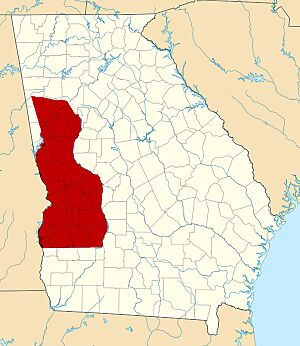Treaty of Indian Springs (1825) facts for kids
The Treaty of Indian Springs was an agreement made between the Muscogee people (also known as the Creek Nation) and the United States. It was signed on February 12, 1825, at a place called Indian Springs. This treaty is sometimes called the Second Treaty of Indian Springs or the Treaty with the Creeks.
What Happened Before?
Before this treaty, the Muscogee and the United States had signed another agreement in 1821. It was called the First Treaty of Indian Springs. In that agreement, the Muscogee gave up land east of the Flint River to the state of Georgia. The U.S. government paid them $200,000 over time and helped pay off their debts to people in Georgia.
In late 1824, American representatives tried to make a new treaty. They wanted the Muscogee to give up all their land east of the Mississippi River. However, they were not successful at that time.
The 1825 Treaty
The treaty that was finally agreed upon in 1825 was negotiated with six leaders from the Lower Creek people. Their main leader was William McIntosh. McIntosh agreed to give up all Muscogee lands east of the Chattahoochee River. This included the important Ocmulgee National Monument area. These lands were given to Georgia and Alabama.
The treaty also said that the Muscogee people would move west. They would go to a similar amount of land along the Arkansas River. To help them move and get supplies, the Muscogee Nation would receive $200,000. This money would be paid in smaller amounts over several years.
What Happened After the Treaty?
The United States Senate approved the treaty on March 7, 1825. It passed by only one vote. People in Georgia were very happy about the treaty. The governor of Georgia, George Troup, was re-elected in 1825.
However, only six Muscogee leaders had signed the treaty. The main Muscogee National Council did not agree with it. Their rules said it was a very serious offense to sell tribal land without everyone agreeing. Because of this, they ordered that McIntosh and the other Muscogee signers should face consequences.
On April 29, a leader named Menawa from the Upper Creek people took about 200 warriors. They went to McIntosh's home near the Chattahoochee River in Georgia. They killed McIntosh and two other leaders who had signed the treaty. They also set fire to his house. Two of McIntosh's sons-in-law were also supposed to face consequences. One was killed, but the other escaped.
A group from the Muscogee National Council, led by Chief Opothleyahola, went to Washington, D.C. They asked the American president, John Quincy Adams, to cancel the treaty. They then negotiated a new agreement in 1826, called the Treaty of Washington. In this new treaty, the Muscogee gave up most of the lands Georgia wanted. However, the terms were better for them. They kept a small piece of land near the Georgia-Alabama border and the Ocmulgee National Monument. Also, they were not forced to move west.
Governor Troup of Georgia did not accept this new treaty. He ordered that the Muscogee lands be measured for a land lottery. He started forcing the Lower Creek people to leave their homes. President Adams threatened to send federal troops to stop him. However, Adams decided not to when Troup prepared the Georgia militia.


